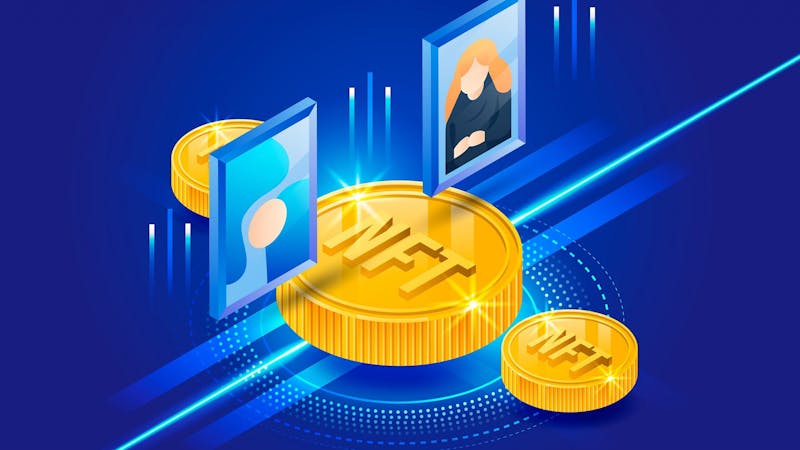In late October 2021, Facebook changed its name to Meta, declared the metaverse to be the future of the internet, and announced its intention to promote and support NFTs. Earlier this year, a startup game developer, backed by former Call of Duty and Fortnite developers, raised over $21 million for their Ethereum-based PC role-playing game with an NFT collection component. These are just two examples showing that big money is betting on NFTs being the next big thing in tech.
Naturally, every big brand wants a slice of the pie. As a result, discussions have cropped up around how NFT technology can provide exclusive user experiences to increase brand awareness and create new revenue streams.
To get to the source of what makes a successful NFT venture we looked at brands doing it well. Brands crushing it with NFTs span consumer goods, fashion, beauty, and tech. Including industry heavyweights Pringles, Gucci, Twitter, and Nike.
But what are the big money-making opportunities? Is it completely overhyped already?
We tackle some of these questions in this article on how brands are using NFTs.
Ways Brands are Using NFT technology
While traditional advertising isn't dead, the NFT explosion in the digital space has evolved how brands can approach products and customers, providing new channels for businesses to add potentially lucrative opportunities into their digital marketing strategies.
Brands are using NFTs to really push traditional advertising boundaries and connect with their audience in an authentic way. Supporting physical advertising efforts by including NFT's to increase brand awareness, provide immersive user experiences and cash in on new revenue streams.
Let’s dive into how NFTs are being used successfully with examples from Brands we know and love.

New User Experience
Brands are creating completely new user experiences with personalized gifts, vouchers, and products that only exist in the digital world.
No other marketing channel is able to create unique relationships between brands and their audience, quite like NFTs. This is because NFT technology can be distributed programmatically across multiple digital platforms.
Pringles, for example, released a limited-edition flavor in the form of a 1080x1080 MP4 file. Only 50 CryptoCrisp exist, and all proceeds from sales went directly to artist @kolotooosha.
Successfully creating an exciting, buzz-worthy experience for customers with an exclusive, one-off product that only exists in the digital world. That excitement, and pride at owning your own NFT? That’s what Pringles tapped into - and that’s the new customer experience you need to provide.

Brand Awareness
High-end fashion companies like Louis Vuitton are using NFTs to reach new customers with obtainable products to create a memorable interaction with customers.
Most recently, Louis Vuitton created a game titled Louis the Game to commemorate the birthday of Louis Vuitton. Within this game, the company included 30 embedded NFTs designed by artist Beeple. Each of these NFT is a collectible that can only be found through playing the game, and they cannot be sold.
The game is not only a great way for Louis Vuitton to brand and get into the metaverse, but it’s also a way for Louis Vuitton to tap into its younger audience.
Louis Vuitton is a brand that caters to the elite and wealthy millennials and Gen-Y customers, but by using an NFT strategy, they can reach out to Gen-Z consumers that are hard to impress and influence.
Brand Loyalty
Brands are modernizing their approach to rewarding customers. Rather than buying an NFT, they are rewarded for engaging with or purchasing from the company.
Rewarding customers with NFTs created new opportunities for collaboration across industries and more creative rewards than the basic "points" system.
For example, Superplastic partnered with Gucci to add special perks for its NFT buyers. These perks included additional customer tokens, early access to Gucci's online and physical stores, and their in-progress restaurant in Miami.

Create Viral Buzz
The combination of virality and scarcity is what makes viral NFTs so attractive.
Viral NFTs are the new way for creators and fans to connect. A Brand may decide to turn their content with a social media influencer into NFTs.
People love to collect items that are rare and valuable. NFTs let your audience own an iconic moment in exclusive or limited editions.
As sa brand, you could select your most relevant or iconic moments in time and let your customer base buy and sell that exclusive NFT.
Former CEO of Twitter, Jack Dorsey, did just that. He sold Twitter’s first-ever tweet for $2.9 million dollars and then donated the proceeds to Give Directly Africa Response fund for Covid-19 relief.
Offering an iconic moment in time as an NFT and donating proceeds to charity is a great way for brands to successfully enter the community. Tech-savvy millennial buyers are more likely to buy products from purpose-driven brands.
New Revenue Stream
NFTs open up a whole new revenue stream for brands by selling goods in digital form or as a complement to a physical offering.
For example. Nike pairs physical products with a digital rendition of the same product, with CryptoKicks. When a customer purchases a physical shoe, Nike will create a digital representation of the shoe and assign a crypto token to the owner.
Owners of CryptoKicks are expected to have the option to breed two pairs of digital shoes creating a unique pair of shoes, transcending manufacturing restrictions.
Another way brands are monetizing NFTs is by creating early access opportunities. Early access creates a viral organic buzz by releasing a campaign of NFTs leading up to the new product launch.

Sourcing Feedback
Traditionally, companies have relied on surveys to obtain feedback and improve their overall business. Incentivizing participation with discounts, referral benefits, or additional products. There is a big opportunity for NFTs to change the way brands source feedback.
What if companies provided NFTs instead of the traditional offerings? The NFT would be unique to the loyal customer and may drive a greater perceived value than discounts or a one-off product.
Elevate your brand with insightful brand perception surveys crafted through strategic timing and diversified questioning covering cognitive, emotional, language, and action aspects. Harness powerful tools like Qualtrics and Typeform to delve deep into customer perspectives, informing marketing strategies that resonate strongly with your target audience. Learn from successful case studies and adapt strategies that foster positive brand perception and loyalty. It's more than a survey; it's the roadmap to a triumphant brand future. Begin your journey towards shaping a formidable brand presence with our comprehensive guide today.
Learn about Crafting an Effective Brand Perception Survey
Final Thoughts
NFTs open a world of opportunity for Brands to connect directly with their consumer and to transcend traditional advertising restrictions.
Big money-making opportunities exist in creating new user experiences, increasing brand awareness, improving loyalty, creating organic buzz and sourcing feedback.
Ready to get your own NFT off the ground? Check out our guide to marketing your NFT project.
Bonus: Learn more about crypto advertising and how to target cryptocurrency users.


